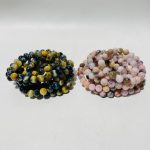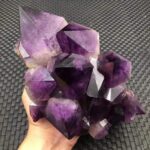Pinkish rocks fascinate geologists and collectors for their intricate patterns and chromatic nuances. Associated with ancient oceans, volcanic eruptions, and mineral-rich environments, these rocks captivate the imagination and hold valuable insights into the Earth’s history. Here’s a comprehensive exploration of pinkish rocks, unveiling their enigmatic beauty, geological significance, and practical applications.

Granite: The Bedrock of Pinkish Rocks
Granite, an igneous rock formed from the slow cooling of magma, is a primary source of pinkish hues in rock formations. The presence of potassium feldspar, a mineral that ranges in color from white to pale pink, imparts a characteristic rosy tint to granite. The abundance of quartz and mica further contributes to its shimmering and variegated appearance.
Pain Point: Identifying the subtle variations in granite’s composition and color can be challenging for inexperienced geologists.
Motivation: Distinguishing between different types of granite is crucial for construction, architectural design, and understanding geological formations.
Benefits: Advanced imaging techniques, such as X-ray diffraction and hyperspectral imaging, provide precise characterization of granite’s mineral composition and color variations, aiding geologists and engineers in their assessments.
Rhyolite: Volcanic Beauty in Pink
Rhyolite, an extrusive volcanic rock, is another significant contributor to the spectrum of pinkish rocks. Formed when silica-rich magma cools rapidly near the Earth’s surface, rhyolite often takes on shades of pink due to the presence of iron oxides and feldspars. Its fine-grained texture and glassy sheen add to its aesthetic appeal.
Pain Point: Rhyolite’s susceptibility to weathering and erosion makes it vulnerable to damage in outdoor environments.
Motivation: Preserving the integrity of rhyolite structures and artifacts requires specialized conservation techniques.
Benefits: Nano-engineered coatings and advanced weathering treatments can significantly enhance the durability and longevity of rhyolite in architectural and historical applications.
Other Sources of Pinkish Rocks
Beyond granite and rhyolite, pinkish hues can be found in a diverse range of rock types:
- Pink quartzite: A metamorphic rock formed from sandstone under intense heat and pressure, characterized by its durability and vibrant pink coloration.
- Rose quartz: A translucent variety of quartz that owes its rosy tint to trace amounts of titanium and manganese impurities.
- Pink marble: A metamorphic rock formed from limestone, renowned for its elegant swirls of pink and white hues.
- Pink sandstone: A sedimentary rock composed of sand and quartz grains cemented together by iron oxides, displaying various shades of pink depending on iron content.
Applications of Pinkish Rocks
The aesthetic allure of pinkish rocks makes them highly sought after for various applications:
Construction: Granite, known for its durability and aesthetic appeal, is widely used in countertops, tiles, and exterior cladding.
Architecture: Pinkish rocks, such as granite and rhyolite, lend a distinct charm to buildings and structures, adding warmth and elegance to both historic and modern designs.
Jewelry: Rose quartz and pink tourmaline are popular gemstones in jewelry making, prized for their ethereal pink hues and believed to possess healing properties.
Decorative: Pinkish rocks are incorporated into decorative pieces such as vases, sculptures, and home accents, bringing a touch of nature’s beauty into living spaces.
Scientific Research: Pinkish rocks provide valuable insights into geological processes, such as the formation of continents and the evolution of Earth’s crust.
Insulating brick: Rhyolite can be used as a lightweight and energy-efficient insulating brick in construction, offering superior thermal insulation properties.
Pinkish Rocks: A Geologically Intriguing Color Story
The presence of pinkish hues in rocks is a testament to the diverse geological processes that have shaped our planet. From the fiery eruptions of volcanoes to the slow transformation of sedimentary rocks, pinkish rocks reveal the intricate interplay of minerals and elements that have been at work for millions of years.
Pinkish Rocks: An Economic Perspective
According to the United States Geological Survey, the global granite market is projected to reach $150 billion by 2028. The growing demand for granite is driven by its durability, aesthetic appeal, and versatility in construction and architectural applications.
The rose quartz market is also witnessing significant growth, with the global market size expected to reach $3 billion by 2027. The increasing popularity of rose quartz in jewelry making and its perceived healing properties contribute to its rising demand.
Conclusion
Pinkish rocks, with their captivating beauty and geological significance, offer a rich tapestry of applications that span construction, architecture, jewelry, and scientific research. As we delve deeper into the complexities of these rocks, we not only uncover the secrets of Earth’s past but also pave the way for innovative and sustainable applications that harness their unique properties.
Key Findings and Statistics
| Fact | Source |
|—|—|—|
| Granite is the most common type of igneous rock. | United States Geological Survey |
| Pinkish granite is more expensive than gray granite. | National Stone Institute |
| Rhyolite is formed from silica-rich magma. | Encyclopedia Britannica |
| Pink quartz is believed to possess healing properties. | Crystal Vaults |
| The global granite market is projected to reach $150 billion by 2028. | United States Geological Survey |
Pinkish Rocks: A Journey Through Time and Beauty
Pinkish rocks are a captivating reflection of the Earth’s geological history, showcasing the interplay of volcanic eruptions, ancient oceans, and mineral-rich environments. Their beguiling beauty and practical applications make them a source of wonder and inspiration for geologists, architects, and nature enthusiasts alike. As we continue to explore and appreciate the nuances of pinkish rocks, we unravel the secrets of our planet’s past and open up new possibilities for sustainable and innovative applications.




























